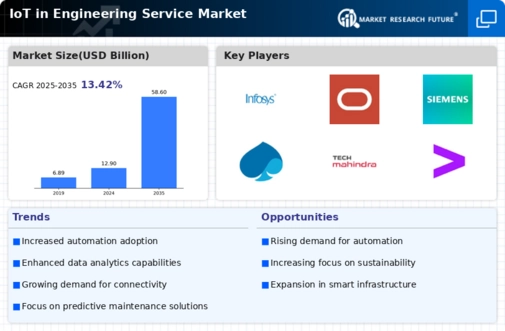Integration of Smart Technologies
The integration of smart technologies into engineering services is a pivotal driver in the IoT in Engineering Service Market. The advent of smart sensors, connected devices, and advanced analytics is transforming traditional engineering practices. These technologies facilitate real-time data collection and analysis, enabling engineers to make informed decisions swiftly. For instance, smart sensors can monitor structural integrity in construction projects, ensuring safety and compliance. The market for smart technologies in engineering services is projected to expand significantly, with estimates suggesting a compound annual growth rate of over 20% in the coming years. This integration not only enhances operational efficiency but also fosters innovation, making it a crucial factor in the evolution of the IoT in Engineering Service Market.
Rising Demand for Predictive Maintenance
The IoT in Engineering Service Market is witnessing a notable rise in demand for predictive maintenance solutions. Organizations are increasingly adopting IoT technologies to monitor equipment health in real-time, thereby reducing downtime and maintenance costs. According to recent data, predictive maintenance can lead to a 10-15% reduction in maintenance costs and a 20-25% increase in equipment uptime. This trend is driven by the need for operational efficiency and cost-effectiveness, as companies seek to leverage data analytics to anticipate failures before they occur. The integration of IoT devices enables continuous monitoring and analysis, allowing for timely interventions. As industries become more competitive, the emphasis on predictive maintenance is likely to grow, positioning it as a key driver in the IoT in Engineering Service Market.
Advancements in Connectivity Technologies
Advancements in connectivity technologies are playing a crucial role in the growth of the IoT in Engineering Service Market. The proliferation of 5G networks and improved wireless communication protocols are enabling seamless connectivity between devices and systems. This enhanced connectivity allows for faster data transmission and more reliable communication, which is essential for real-time monitoring and control in engineering services. As industries adopt IoT solutions, the demand for robust connectivity is expected to surge, with projections indicating a significant increase in the number of connected devices in the coming years. This trend not only enhances operational efficiency but also opens new avenues for innovation, making advancements in connectivity a vital driver in the IoT in Engineering Service Market.
Regulatory Compliance and Safety Standards
Regulatory compliance and adherence to safety standards are increasingly influencing the IoT in Engineering Service Market. As industries face stringent regulations regarding safety and environmental impact, the implementation of IoT solutions becomes essential. IoT technologies enable organizations to monitor compliance in real-time, ensuring that safety protocols are followed. For example, in the construction sector, IoT devices can track worker safety and equipment usage, reducing the risk of accidents. The market for compliance-related IoT solutions is expected to grow, driven by the need for transparency and accountability. Companies that leverage IoT for compliance not only mitigate risks but also enhance their reputation, making this a significant driver in the IoT in Engineering Service Market.
Growing Focus on Data-Driven Decision Making
The growing focus on data-driven decision making is reshaping the landscape of the IoT in Engineering Service Market. Organizations are increasingly recognizing the value of data analytics in optimizing operations and enhancing productivity. By harnessing IoT-generated data, companies can gain insights into performance metrics, resource utilization, and operational bottlenecks. This shift towards data-centric strategies is expected to propel the market, with forecasts indicating a potential increase in market size by over 30% in the next five years. The ability to make informed decisions based on real-time data not only improves efficiency but also fosters innovation, positioning data-driven decision making as a key driver in the IoT in Engineering Service Market.


















Leave a Comment